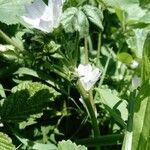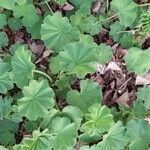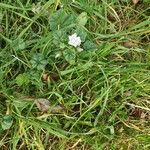Herb, the stem commonly procumbent or trailing, usually branched, up to 2 m long, appressed-stellate-pubescent. Leaves with a slender petiole up to 20 cm long, rather sparsely stellate-pubescent, the stipules ovate, acute or acuminate, 4-7 mm long; blade circular or circular-reniform, deeply cordate, very shallowly several-lobed, ca 1-6 cm long and broad, the margins crenate-denticulate, 5-to 7-palmi-nerved, strigose on both sides with simple or stellate hairs, densely so when young, the venation prominulous beneath. Flowers solitary or in loose, few-flowered clus-ters, the pedicel slender, 2-4 cm long, stellate-puberulus to stellate-tomentellous; epicalyx bractlets linear-ovate, acute, ca 4 mm long and 0.8 mm wide, stellate-puberulus and ciliolate along the margin; calyx ca 5-6 mm long, densely stellate-puberulus, lobed to or little beyond the middle, the lobes deltoid and acuminate, somewhat accrescent and enclosing the schizocarp; petals ca 12 mm long, the claws barbate, white and usually lavender toward the apex; androecium ca 6-7 mm long, the staminal tube sparsely and minutely stellate-puberulus; styles ca 8-9 mm long. Fruit ca 5-6 mm in diam, the mericarps 12-15, smooth, very minutely puberulus.
Annual or short-lived perennial, procumbent to ascending herb. Stems sparsely to densely clothed in stellate hairs. Lvs sparsely to moderately clothed in mostly stellate hairs above, densely hairy below, reniform to orbicular, cordate, shallowly 5-7-palmately lobed and crenate, 1-7-(8) cm diam.; petioles (2)-4-20 cm long; stipules triangular, 3-6 mm long. Fls in axillary clusters of 2-5; fruiting pedicels 1-8 cm long; epicalyx segments linear to narrowly ovate-oblong, < calyx; calyx teeth ovate-triangular, acuminate, with stellate hairs and ciliate, not enlarged at fruiting; petals white to lilac, often with lilac to pink veins, usually at least twice as long as calyx, (7)-8-15 mm long. Mericarps 12-15 per fr., hairy, rarely sparsely so, smooth or faintly reticulate on back; edges sharply angled but not winged.
Prostrate to ascending annual or biennial to 1 m, usually branched from the base; lvs long-petioled, orbicular or reniform, 2–6 cm wide, shallowly 5–9-lobed, crenate, with cordate or subcordate base; fls fascicled in the axils, on pedicels to 3 cm; bractlets narrow; pet obcordate, 6–12 mm, white or slightly tinted with pink or purple, twice as long as the sep; mature carpels usually 12–15, rounded on the back and usually finely hairy, not rugose or reticulate, the lateral faces not radially veined, the whole ring of carpels with a crenate outline, the depressed central portion of the head a third as wide as the head; 2n=42. Native of Eurasia and n. Afr., now abundant as a weed in gardens and waste places throughout temperate N. Amer. May–Oct.
Perennial herb, often decumbent, rosettes up to 1 m in diam. Leaves simple, orbicular-reniform with deep, triangular, basal sinus, undivided to very shallowly palmately lobed, crenate-denticulate. Flowers axillary, solitary or in fascicles of up to 4, white, mauve towards apex with purplish veins. Epicalyx of 3 linear-lanceolate bracts fused at base of calyx, shorter than calyx. Flowering time Nov.-Apr. Fruit a discoid schizocarp with a depressed centre, enclosed by accrescently lobed calyx. Mericarps (12-)14-16, shortly stellate-pilose, lateral angles rounded. Seeds reniform.
An annual herb about 0.5 m high. It is mostly low lying. The leaves are round or kidney shaped and 2-5 cm across. They have shallow lobes and a wavy edge. There are fine teeth around the edge. The flowers are pale lilac with darker veins. They are small and in stalked clusters in the axils of leaves. The petals are deeply notched on the outer edges. The fruit are nutlets which are brownish-green when ripe. They have smooth hairy backs.
Leaf-lamina 1–6 × 1–6 cm., orbicular-reniform with deep triangular basal sinus, crenate-denticulate, that of leaves on elongated branches very shallowly 5–7-lobed, sparsely strigose on both sides, the hairs often simple on upper surface and stellate on lower surface; petiole 3–20 cm. long, softly and sparsely stellate-pilose; stipules ovate-acuminate or ovate-lanceolate, acute.
Perennial herb with strong deep penetrating taproot up to 20 cm. in length; stems stout and woody in basal portion, those developing in the warmer season decumbent and forming flat rosettes up to about 1 m. in diam., those formed in colder seasons abbreviated with very short internodes, all sparsely and more or less appressed-stellate-pubescent.
Perennial herb. Stems decumbent. Leaves with blade orbicular-reniform, slightly lobed, 10-60 x 10-60 mm. Flowers: petals longer than sepals, petals with claws bearded, white with mauve or purplish veins; Oct.-Jan. Fruit with mericarps pilose.
Decumbent perennial herb. Leaves slightly lobed, 10-60 mm long, on 30-200 mm long petioles. Petal claws bearded. Mericarps 12-15, pilose. Flowers white with mauve or purplish veins.
Calyx 5–7 mm. long, stellate-pilose, lobed to or a little beyond the middle, later somewhat accrescent and enclosing the fruit; lobes triangular-ovate, acute, ± ciliate.
Petals 10–13 mm. long, white, usually with mauve or purplish veins and mauve or pale purple towards the apex, the claws barbate.
Flowers in fascicles of up to 4 or (in lower portions of stems) solitary; pedicels 2–5 cm. long, sparsely stellate-pubescent.
Fruit 6–8 mm. in diam., of 12–15 smooth shortly stellate-pilose mericarps with rounded lateral angles.
Epicalyx-lobes 3–4 mm. long, linear-lanceolate.
Staminal tube pubescent.












